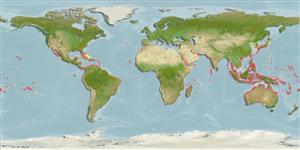Environment: milieu / climate zone / Tiefenbereich / distribution range
Ökologie
seewasser; brackwasser riff-verbunden; ozeanodrom (Ref. 51243); tiefenbereich 0 - 3 m (Ref. 58047). Subtropical; 43°N - 37°S, 180°W - 180°E
Worldwide distribution in tropical and warm temperate waters. Eastern Atlantic: Cape Verde and Dakar to Moçamedes, Angola (Ref. 5757); ranging further south to Namibia (Ref. 12484). Western Atlantic: Chesapeake Bay (USA), Bermuda, and northern Gulf of Mexico to Brazil (Ref. 7251). Throughout the Indian Ocean. Western Pacific: off coasts and islands from southern Japan through the East Indies to Australia (Ref. 9682). Reported from Tuvalu (Ref. 12690). Eastern Pacific: Mexico to Peru. Entire Caribbean, Antilles and South American coast to Rio de Janeiro (Ref. 26938).
Size / Gewicht / Alter
Geschlechtsreife: Lm ? range ? - ? cm
Max length : 140 cm TL Männchen/unbestimmt; (Ref. 40637); common length : 70.0 cm SL Männchen/unbestimmt; (Ref. 9279); max. veröff. Gewicht: 4.8 kg (Ref. 40637)
Rückenflossenstacheln (insgesamt) : 0; Rückenflossenweichstrahlen (insgesamt) : 23 - 26; Afterflossenstacheln: 0; Afterflossenweichstrahlen: 24 - 28; Wirbelzahl: 86 - 93. Dark bluish dorsally, silvery white ventrally with black blotches on middle of body (Ref. 5317). Body greatly compressed laterally; anterior parts of dorsal and anal fins with high falcate lobes. Pectoral fins falcate; about 12-14 prominent dark vertical bars on body; juveniles and adults have an elevated black lobe in the posterior part of the dorsal fin.
Body shape (shape guide): elongated.
Inhabits neritic and oceanic waters but more often found near islands (Ref. 5213). Found in estuaries (Ref. 26340), and coastal rivers (Ref. 33587). Sometimes forming large schools (Ref. 5217). Feeds mainly on small fishes (Ref. 9279). Oviparous (Ref. 205). Eggs may be found attached to objects in the water by filaments on the egg's surface (Ref. 205). Since the jaws are frequently broken, the maximum length is given as body length excluding head and caudal fin. Usually caught with the help of artificial lights (Ref. 9279). Marketed fresh and salted; smoked or frozen (Ref. 9987). Market limited due to the green-colored flesh (Ref. 5217). In females, only left gonad is developed, and in males the right gonad is small or absent (Ref. 26938).
Collette, B.B., 1999. Belonidae. Needlefishes. p. 2151-2161. In K.E. Carpenter and V.H. Niem (eds.) FAO species identification guide for fishery purposes. The living marine resources of the Western Central Pacific. Volume 4. Bony fishes part 2 (Mugilidae to Carangidae). FAO, Rome. (Ref. 9682)
IUCN Rote Liste Status (Ref. 130435: Version 2025-1)
Bedrohung für Menschen
Harmless
Nutzung durch Menschen
Fischereien: weniger kommerziell; Sportfisch: ja
Tools
Zusatzinformationen
Download XML
Internet Quellen
Estimates based on models
Preferred temperature (Ref.
123201): 22.6 - 29.2, mean 27.9 °C (based on 4228 cells).
Phylogenetic diversity index (Ref.
82804): PD
50 = 0.6250 [Uniqueness, from 0.5 = low to 2.0 = high].
Bayesian length-weight: a=0.00089 (0.00053 - 0.00151), b=3.10 (2.96 - 3.24), in cm total length, based on LWR estimates for this species & (Sub)family-body (Ref.
93245).
Trophic level (Ref.
69278): 4.2 ±0.66 se; based on food items.
Generation time: 1.8 ( na - na) years. Estimated as median ln(3)/K based on 1
growth studies.
Widerstandsfähigkeit (Ref.
120179): mittel, Verdopplung der Population dauert 1,4 - 4,4 Jahre. (Assuming tmax>3; K=0.6).
Fishing Vulnerability (Ref.
59153): Moderate vulnerability (40 of 100).
🛈
Climate Vulnerability (Ref.
125649): High to very high vulnerability (74 of 100).
🛈
Nutrients (Ref.
124155): Calcium = 40.3 [10.1, 162.5] mg/100g; Iron = 0.555 [0.225, 1.432] mg/100g; Protein = 18.8 [16.7, 20.9] %; Omega3 = 0.168 [0.064, 0.510] g/100g; Selenium = 13.3 [5.2, 39.4] μg/100g; VitaminA = 36.3 [8.3, 189.8] μg/100g; Zinc = 0.516 [0.290, 0.962] mg/100g (wet weight);
